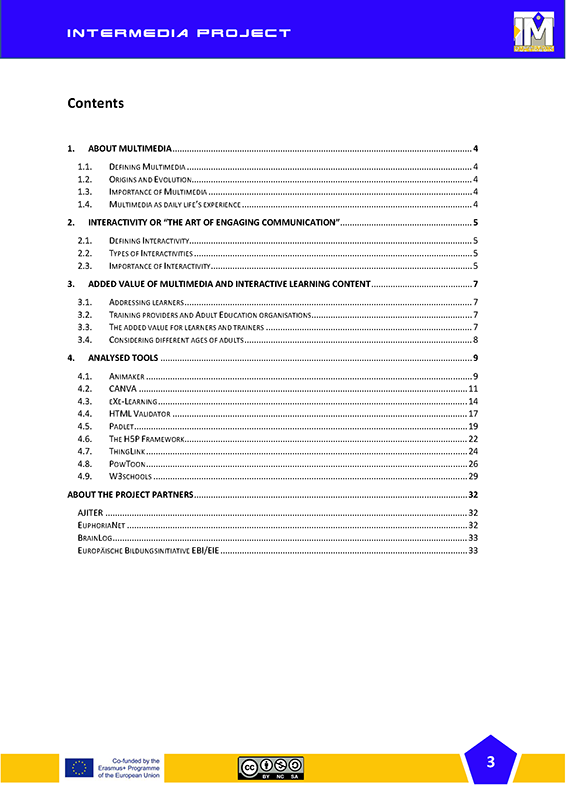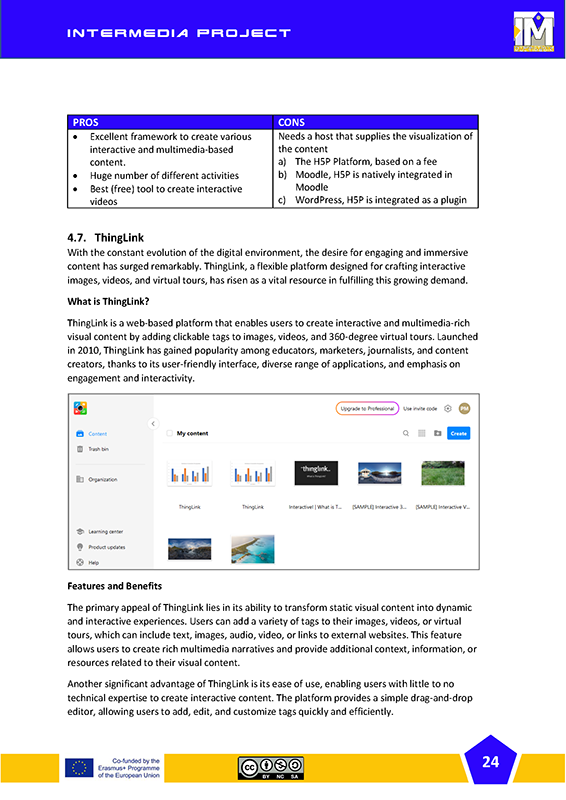Contents
This Multimedia Tools Report delves into the realm of multimedia and interactive learning, investigating their definitions, origins, evolution, and significance in our daily lives. The concept of interactivity, regarded as the art of engaging communication, is explored in terms of its definition, various types, and its importance within multimedia experiences. Furthermore, the added value of multimedia and interactive learning content is discussed, with a focus on addressing learners, training providers, and adult education organizations. The benefits for both learners and trainers are explored, taking into consideration the different age groups of adult learners.
Additionally, this document presents an analysis of several tools used in the creation and implementation of multimedia and interactive learning content. The tools discussed include Animaker, a platform for creating animated videos; Canva, a versatile graphic design tool; EXE-Learning, an e-learning authoring tool; HTML Validator, a tool for validating HTML code; Padlet, an online collaborative platform; the H5P framework, an interactive content creation tool; ThingLink, a platform for creating interactive images and videos; Powtoon, a platform for creating animated presentations; and W3Schools, an online resource for web development tutorials.
By exploring these tools, this document aims to provide a comprehensive overview of the diverse options available for creating engaging and interactive multimedia content, ultimately enhancing the learning experience for a wide range of audiences.
Multimedia-based and Interactive Tools (InterMedia) by Peter Mazohl
Importance of multimedia content
Adult learners highly appreciate the integration of multimedia and interactivity in their learning process. Multimedia brings added value by engaging multiple senses, fostering more profound understanding, and enhancing knowledge retention. It provides a dynamic and interactive learning experience that aligns with the principles of active learning. Adults actively participate, explore, and manipulate content, promoting critical thinking and problem-solving skills.
By incorporating multimedia, such as videos, animations, and interactive exercises, adult learners can connect theory to real-world scenarios, making the learning journey more relevant and practical. Multimedia also caters to different learning styles, accommodating visual, auditory, and kinesthetic preferences. This versatility allows adults to engage with content in a way that resonates with their individual needs.
Collaboration and peer-to-peer learning
Additionally, interactivity promotes collaboration, networking, and peer-to-peer learning among adult learners, creating a supportive and engaging learning community. Through interactive elements like discussions, simulations, and group activities, adults can apply their knowledge, exchange ideas, and learn from each other’s experiences.
The combination of multimedia and interactivity nurtures a learner-centered approach, empowering adults to take ownership of their learning and fostering a positive and effective learning environment. Ultimately, the integration of multimedia in the framework of active learning significantly enhances adult learners’ educational experience, making it more engaging, relevant, and impactful.
Example pages of the “Multimedia Report”
Views: 4


